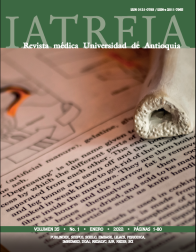Conocimientos del pie diabético en el personal médico en formación de la Universidad de Antioquia
DOI:
https://doi.org/10.17533/udea.iatreia.99Palabras clave:
amputación, conocimiento, pie diabéticoResumen
Introducción: el pie diabético es el causante de casi el 85 % de las amputaciones no traumáticas, ocasionando discapacidades importantes. Por ello, el personal de la salud debe estar capacitado para el reconocimiento temprano de esta condición, así como para su adecuado tratamiento. Por lo anterior, nos proponemos recopilar el conocimiento que tienen los médicos en formación del último año de la carrera Medicina de la Universidad de Antioquia, para la evaluación del pie diabético y la estratificación del riesgo de amputación.
Métodos: los participantes fueron estudiantes de medicina del último año de la Universidad de Antioquia. A estos se les realizó un cuestionario que debían autodiligenciar, que constaba de 22 preguntas acerca del conocimiento sobre la evaluación y estratificación del riesgo de amputación en los pacientes con pie diabético.
Resultados: fueron 148 participantes. En general, los conocimientos sobre la evaluación y estratificación el riesgo son bajos. El 16,9 % de los participantes saben realizar la prueba de monofilamento y el 22,3 % sabe interpretarla. También existe un desconocimiento acerca de los factores de riesgo para la amputación; solo el 20,9 % de los encuestados demuestran conocimientos del tema.
Conclusión: el nivel de conocimiento sobre pie diabético, su diagnóstico y estratificación del riesgo es baja en los participantes del estudio. Lo anterior indica que los estudiantes de último año de medicina de la universidad de Antioquia poseen una información superficial sobre el tema, lo cual puede llevar a un retraso en el diagnóstico y la implementación de un tratamiento oportuno.
Descargas
Citas
(1) IDF. Diabetes Atlas. 7.ed. [Internet]. Bruselas: IDF; 2015. [Consultado 2019 nov. 20]. Disponible en: https://cutt.ly/ijOloUB
(2) DANE [internet]. Bogotá: DANE; 1998. [Consultado 15 abr 2020]. Disponible en: https://cutt.ly/mjOxZu5
(3) Van Netten J, Bus N, Apelqvist J, Lipsky B, Hinchliffe R, Game F, et al. Definitions and criteria for diabetic foot
disease. Diabetes Metab Res Rev. 2020 Mar;36 Suppl 1:e3268. DOI 10.1002/dmrr.3268.
(4) Boike A, Logan D. Prevention and Treatment of Leg and Foot Ulcers in Diabetes Mellitus [internet]. [Consultado en 2019 nov 20]. Disponible en: https://cutt.ly/JjOviun
(5) Boulton AJ. The pathway to foot ulceration in diabetes. Med Clin North Am. 2013 Sep;97(5):775-90. DOI 10.1016/j.mcna.2013.03.007.
(6) Lim JZ, Ng NS, Thomas C. Prevention and treatment of diabetic foot ulcers. J R Soc Med. 2017 Mar;110(3):104-9. DOI 10.1177/0141076816688346.
(7) Singh N, Armstrong DG, Lipsky BA. Preventing foot ulcers in patients with diabetes. JAMA. 2005 Jan 12;293(2):217-28. DOI 10.1001/jama.293.2.217.
(8) Boulton AJ, Vileikyte L, Ragnarson-Tennvall G, Apelqvist J. The global burden of diabetic foot disease. Lancet. 2005 Nov 12;366(9498):1719-24. DOI 10.1016/S0140-6736(05)67698-2.
(9) Boulton AJ. Diabetic neuropathy and foot complications. Handb Clin Neurol. 2014;126:97-107. DOI 10.1016/B978-0-444-53480-4.00008-4.
(10) Schoen DE, Gausia K, Glance DG, Thompson SC. Improving rural and remote practitioners’ knowledge of the diabetic foot: findings from an educational intervention. J Foot Ankle Res. 2016 Jul 29;9:26. DOI 10.1186/s13047-016-0157-2.
(11) Mishra SC, Chhatbar KC, Kashikar A, Mehndiratta A. Diabetic foot. BMJ. 2017 Nov 16;359:j5064. DOI 10.1136/bmj.j5064.
(12) Orduz A, Tique C, Stetphens I, González A, Noel B, Tamayo D. Pie risk, una herramienta para la prevención del pie diabético. diabético. Revista Colonbiana de endocrinologia, diabetes y metabolismo. 2016;1(3):25-34.
(13) Abdulwassi H, Safhi M, Hashim R, Fallatah A, Hussein S, Almusallam S, et al. Knowledge of diabetic foot care management among medical students at King Abdulaziz University Hospital, Jeddah, Saudi Arabia. Saudi Med J. 2019;41(1):59-67. DOI 10.15537/smj.2020.1.24812.
(14) Garcia-Klepzig JL, Sánchez-Ríos JP, Manu C, Ahluwalia R, Lüdemann C, Meloni M, et al. Perception of diabetic foot ulcers among general practitioners in four European countries: knowledge, skills and urgency. J Wound Care. 2018 May 2;27(5):310-319. DOI 10.12968/jowc.2018.27.5.310.
(15) Colpedis. Guías colombianas para la prevención diagnóstico y tratamiento del pie diabético. Un manejo integral 2019. [internet]. [Consultado 2019 nov 49]. Disponible en: https://cutt.ly/vjP16EM
(16) NICE. Diabetic foot problems: prevention and management [internet]. [Consultado 2019 noviembre 2]. Disponible en: https://cutt.ly/qjP0pYT
(17) Pankhurst CJW, Edmonds ME. Barriers to foot care in patients with diabetes as identified by healthcare professionals. Diabet Med. 2018 Aug;35(8):1072-1077. DOI 10.1111/dme.13653.
(18) Forsetlund L, Bjørndal A, Rashidian A, Jamtvedt G, O’Brien MA, Wolf F, et al. Continuing education meetings and workshops: effects on professional practice and health care outcomes. Cochrane Database Syst Rev. 2009 Apr 15;2009(2):CD003030. DOI 10.1002/14651858.CD003030.pub2.
Publicado
Cómo citar
Número
Sección
Licencia
Derechos de autor 2021 Universidad de Antioquia

Esta obra está bajo una licencia internacional Creative Commons Atribución-NoComercial-CompartirIgual 4.0.
Los artículos publicados en la revista están disponibles para ser utilizados bajo la licencia Creative Commons, específicamente son de Reconocimiento-NoComercial-CompartirIgual 4.0 Internacional.
Los trabajos enviados deben ser inéditos y suministrados exclusivamente a la Revista; se exige al autor que envía sus contribuciones presentar los formatos: presentación de artículo y responsabilidad de autoría completamente diligenciados.














